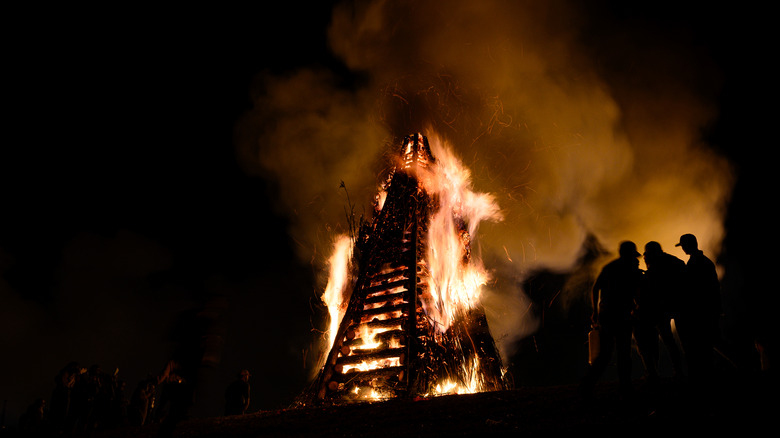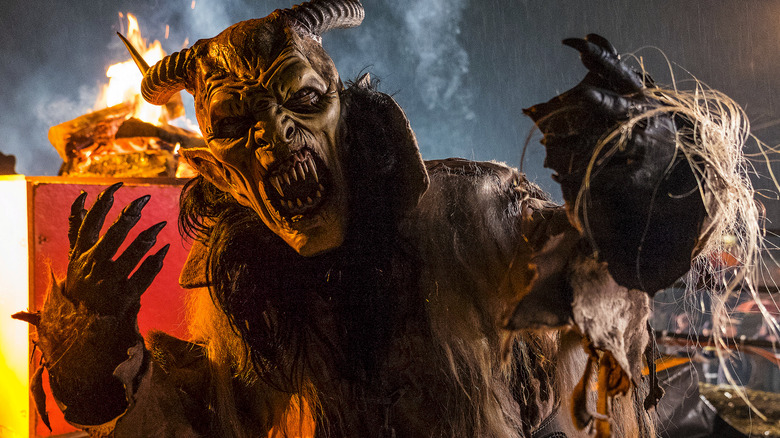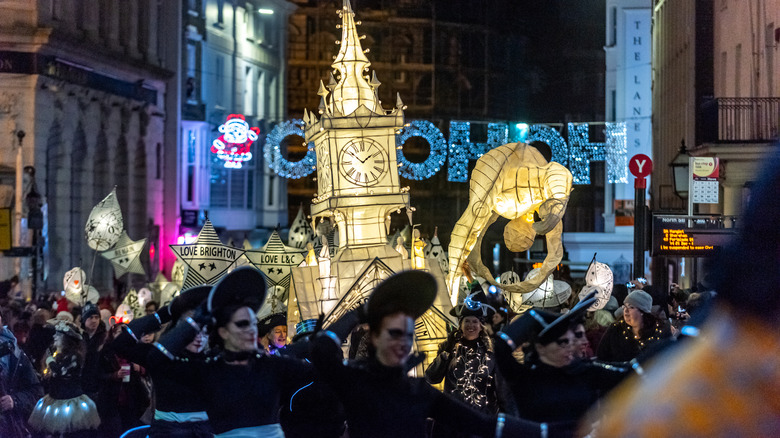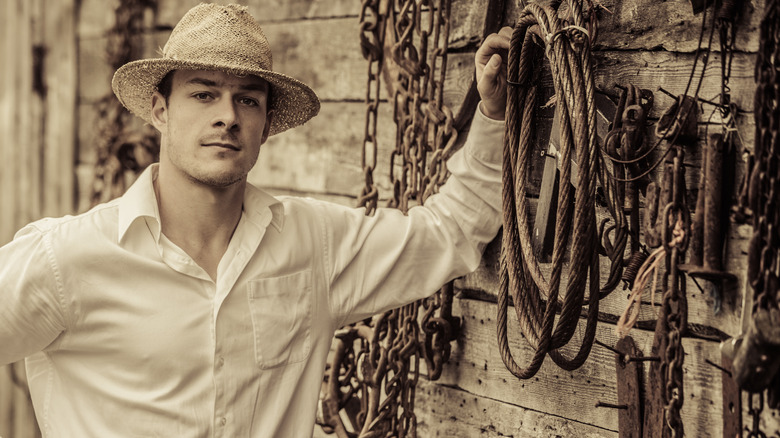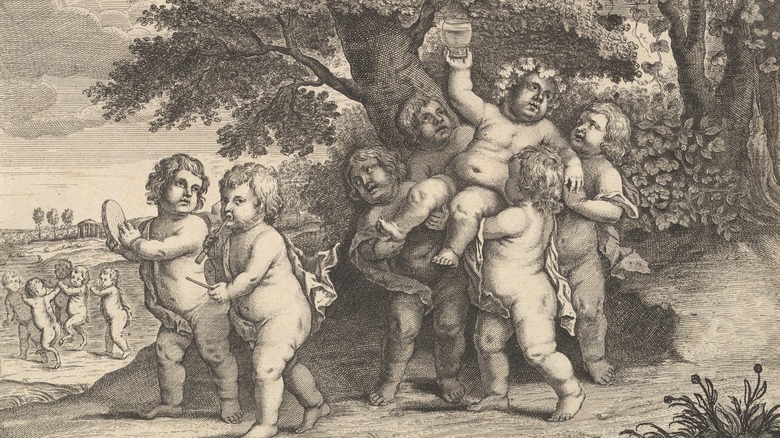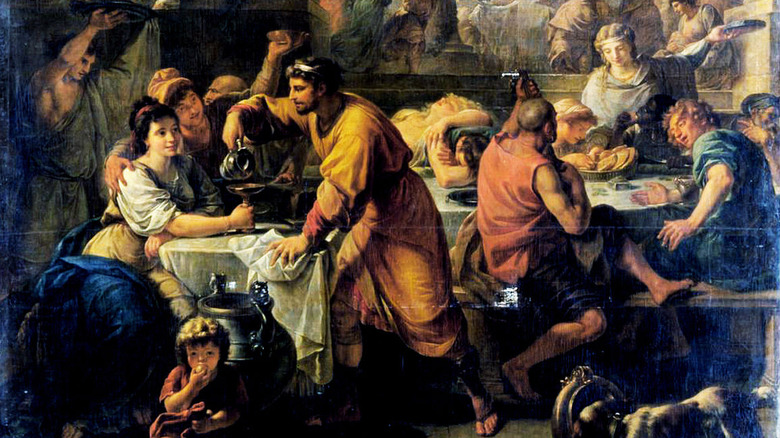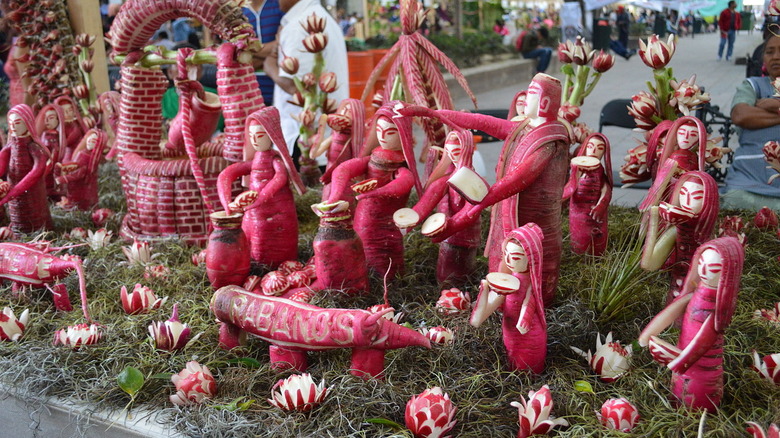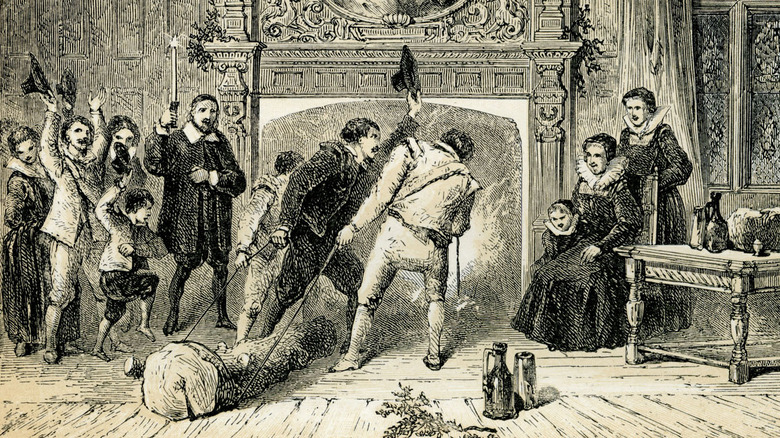Other Winter Holidays To Celebrate If Christmas Isn't Your Thing
If there's anything that can be safely said about Christmas, it's that it's pretty relentless. Celebrations, merchandise, decorations, and carols on the radio seem to start earlier every year, and it seems as though "Christmas in July" might be a very real thing sometime soon.
But Christmas isn't for everyone. Religious beliefs aside, not everyone wants to spend months basking in the glow of Christmas tree lights, drinking peppermint mochas, and carrying around mistletoe. There are a million and one reasons Christmas might be a less-than-appreciated holiday — there's plenty of potential for bad memories, a dislike of the commercialism, or even the desire to never see some family members ever again. For others, it can be missing loved ones that make Christmas feel like just too much.
Just because someone doesn't want to celebrate Christmas, that doesn't mean they need to miss out on some holiday cheer — and sometimes, something just a little bit different is exactly what's needed to bring back a festive spirit. With that in mind, let's talk about some other winter festivals that might be the perfect cause for celebration in lieu of (or alongside) Christmas. Some are ancient, some are obscure, and some are still celebrated in corners of the world. Join in!
Bonfires on the Levee
Love hanging out with friends and family around a roaring bonfire? Yes? In that case, it's Louisiana who has what might be the perfect winter festival, and it's called Bonfires on the Levee. It's exactly that: Families spend some serious time and effort building massive structures that reach up to 20 feet high, and while pyramids are traditional, they can take any shape — as long as they're big, and at best have some sort of connection to life along the Mississippi. While many communities take pride in their Christmas lights, the families along Louisiana's section of the Mississippi take pride in the bonfires that are lit on Christmas Eve.
As the fire burns, there's plenty of people who line the nearby roads to watch. Closer up, families set up barbeques and grills in an atmosphere that Louisiana's official tourism board calls "akin to football tailgating." Pretty fun, right?
They say that it's not clear just how or why the tradition started, but it's been going since at least the 1880s (and probably earlier). Ask anyone why they do it, and the usual response is that it's long been done to help guide Papa Noel and his sleigh pulled by reindeer, but honestly? There's no reason needed: It's just some good, old-fashioned, Christmas Eve fun.
The Rough Night
For anyone who prefers the costumes and eerie atmosphere of Halloween to Christmas, the German and Bavarian tradition of Rauhnacht might be just what the Grinch ordered. Invest in Bavaria says that Rauhnacht — or Rough Night — was first celebrated in 1725, but it's only in the last few decades that it's seen an increase in popularity. These days it's typically celebrated on just one or two days during the time of year when the nights are longest, and that's between the winter solstice and January 6's Epiphany. The belief is that during these long nights, evil spirits and the souls of the dead once again walk among the living.
In order to make sure they don't stay, people don costumes that look just as horrible as the demons, and parade through the town to chase off the spirit. Homes are cleansed with incense, and the children have a part to play, too — also similar to Halloween, they go door-to-door to receive small presents, candy, and sometimes even doughnuts.
And yes, full disclosure: The New York Times says that in the 1930s and 1940s, Rauhnacht was folded into the Nazi's pagan overhaul of Christmas into Julfest. But don't worry — this one can be celebrated with the knowledge that it predates the Nazis by centuries.
Haloea
In later ancient Greek mythology, Poseidon may have gotten a bit of the ol' Aquaman treatment. The early days were pretty different though, and according to the Cambridge University Press, he was once one of the most important gods of the pantheon. He was also the one honored at winter solstice celebrations across the Greek world, and just what the festival called Haloea involved, well, it might be pretty surprising to anyone who just thinks of Poseidon as the god that can talk to fish.
In addition to being the god of the seas, Theoi says he also had an almost shocking number of both lovers and children. The former includes famous names like Medusa, Aphrodite, and his sister Demeter, while his children included Pegasus and the hero Theseus. That's important to know, because his winter solstice festival wasn't just about the sun, it was about the secret things done in the dark, too.
Haloea was held during the month named for Poseidon, which ThoughtCo. says was the modern-day December into January. While women headed off for a girls' night that involved wine, storytelling, and suggestively shaped desserts, men lit bonfires and waited for the women to return the following day. There was also a festival that involved 16 days of feasts — that was called the Poseionia of Aegina. It was so wildly popular that it was eventually extended into two entire months of hard-core feasting, and that really puts all those Christmas parties into perspective, doesn't it?
Burning the Clocks
Same Sky is a British arts charity, and in 1994, they kicked off what's grown into a massive — and absolutely beautiful — festival that's held on the winter solstice in the beachfront town of Brighton. The entire point of the charity is to bring people together no matter what their beliefs or background may be, and that's what makes Burning the Clocks so cool — absolutely everyone can feel welcome.
The main attraction is a parade of more than 2,000 people, who carry illuminated paper lanterns through the town. The willow-and-paper lanterns are said to be filled with all their hopes and dreams, which are released when they're passed into — and burned in — a massive bonfire on the beach. After that, there's plenty of fireworks, music, dancing, and the chance to wear some super fun costumes — which Culture Trip says must contain some depiction of a clock in their design. The idea is to celebrate the passing of time, the return of the sun, and the prospects of the new year — no matter who you are or what you believe. What's not to love?
Handsel Monday
Handsel Monday was Scotland's original holiday work party, and it was a huge deal for hundreds of years. The Scotsman says that it traditionally took place on the first Monday after the New Year (which was once observed on January 12). It was the day when bosses, farmers, and landowners were expected to treat their employees and servants to a day of gifts and food, including cake, coins, and some boozy drinks. Best of all, the workers enjoyed all this while the bosses filled in and did their work for the day.
It's no wonder, then, that the day would start as early as possible, with workers roused by people causing chaos in the streets. There was a hearty breakfast, bonfires, and along with the swapping of gifts, there were plenty of songs that were sung, and drinks that were drunk ... while the bosses toiled away.
Some places had their own traditions: In some areas, people would visit holy wells to take a drink that would help bring them good fortune and health through the coming year, while others would hold impromptu parades. The day would end with families getting together for a few more drinks, in a gathering that would also recognize those who were no longer there.
Brumalia
Historical records are a little fuzzy when it comes to the ancient Roman holiday of Brumalia but given how many days of potential parties it came to include, that's kind of understandable. The University of Sheffield says that it was originally a one-day festival called Bruma, which was kind of a pre-holiday to the winter solstice. Somewhere along the line, that got turned into Brumalia, which started on November 24 and ran for 24 days.
Brumalia is best celebrated among a massive group of friends, and here's why: Every day of the celebration corresponded to a letter of the alphabet, and people were expected to throw a party on the day that had a corresponding letter that matched the letter of their first name. Have 24 friends with names starting with different letters? 24 parties! It's no wonder no one was keeping records by the end.
There are somewhat limited sources when it comes to just what celebrations involved, but according to University of Exeter senior lecturer in Classics and Ancient History Richard Flower (via The Conversation), there was a lot of wine involved. (There were also sacrifices of pigs and goats, but please feel free to keep those out of modern celebrations.) It was devotees of Dionysus who would reportedly inflate skins to jump on like ancient trampolines, which sound like precisely the sort of shenanigans officials would try to ban. And they did try, but Brumalia continued to be celebrated into at least the 10th century.
Saturnalia
After Brumalia came Saturnalia, and for anyone who thinks the Christmas season doesn't contain nearly enough drinking, gambling, and public nudity, this one's for you. (Although, maybe skip the public nudity — that's frowned on these days.) Saturnalia, says History, was the Roman's midwinter festival thrown in honor of their god of agriculture (and pretty much everything else), Saturn. It grew from one day to seven, and HistoryExtra says there was really only one rule: Anything serious was forbidden.
In addition to a ton of feasting, drinking, and public gambling, there were also things like chariot races, decorations, and the burning of candles, meant to represent the return of the sun. Coins and other small gifts were hidden in cakes and desserts, while revelers tossed together mis-matched clothing and hit the streets to dance, sing, and generally cause some chaos.
There was also the choosing of a Lord of Misrule, who was usually the sort of person who spent the rest of the year taking orders and doing the bidding of others. For the duration of Saturnalia, they had a new job: cause as much trouble as possible, up to and including insulting everyone around them.
Night of the Radishes
Here's one for the Halloween fans, particularly those who just love carving pumpkins. Can't get enough of it? Adopt another holiday: the Night of the Radishes. This one is celebrated in Oaxaca, Mexico, and according to the BBC, they've been doing it since the city's mayor declared it an official holiday in 1897. That was the first year that radishes would be carved into little decorative ornaments or figures, and these aren't entirely the normal, garden variety of radishes. Specially grown for the occasion, these radishes can weigh up to around 6 pounds, and the festival is so popular that it attracts throngs of people.
Radishes don't last as long as pumpkins, so timing is key. After they're harvested around December 18 and carved over the following few days, they're put on display for just a few more days until they start to turn brown. Carvings are intricate and pretty incredible, with full dioramas of everything from everyday life to the Last Supper having made appearances at festivals. Culture Trip says there's everything in between, too, from animals and people to recreations of works of art.
It's unclear just how the whole thing started, but one origin story suggests it was started as a way to use radishes that had been left in the ground too long before they were harvested. It's continued as a way to promote local agriculture, and it's a pretty neat festival to celebrate in your own home. Get carving!
The Festival of Bona Dea
"Bona Dea," says the Oxford Classical Dictionary, is a bit of a mystery — starting with the fact that no one's even sure what her name is. That's her title, and it translates to the Good Goddess. She was worshipped in Rome, and every year around mid-winter, Roman women would gather to observe a festival in her honor. Research from Uppsala Universitet did a deep dive into just what the rites, rituals, and beliefs of the cult were, and it's tricky — unsurprisingly, perhaps, for a deity that pre-dates the Roman Empire. Only women were allowed to participate, and most of what we know comes from December celebrations in 63 and 62 BC.
In the first, a ceremonial flame that seemed to light itself was seen as a message that the goddess was blessing the home and inhabitants, while the following year, the ceremonies were nearly ruined when a man named Clodius disguised himself as a woman and entered the house. He was later accused of sacrilege but was found innocent (likely with the help of a few bribes).
Details are scarce, but scholars do know that in addition to the sacrifice of a pregnant pig (which might be replaced with a ham dinner in the 21st century), there was also night-long music, dancing, and the consumption of a lot of wine. The interior of the home was decorated with vines, flowers, and other greenery, along with wine, wine, and more wine. Sounds fun!
La an Dreoilin
First things first: This holiday isn't quite the same as it was in ye olde times, when it was built on some old-fashioned animal cruelty. Today, the few places in Ireland that still hold La an Dreoilin — or Wren Day — festivities use a fake bird, and it's more about the parades, music, dancing, and the food than anything else. Still, let's wade into the tragic history of this weird holiday.
Wren Day is December 26 — that's also St. Stephen's Day. Wren Day traditions are pretty straightforward, says Pilgrimage in Medieval Ireland, and it would start a few days prior to the 26. A group of boys — aptly called The Wren Boys — would head out to find, track, and kill a wren. Then, on the 26th, they would go door-to-door, singing and asking for money to "bury the wren."
Prop birds have been used as far back as the beginning of the 20th century, but still, why the heck was this even a thing? It's tied to St. Stephen: Legend says that the saint was in hiding when he was betrayed by the chirping of the wren, who's been paying for it ever since. Other pieces of folklore suggest that if there was any home that didn't donate, the bird would be laid to rest nearby, and bring 12 months of bad luck.
Want to participate? Modern versions of the holiday focus on the music and dancing, and the money raised is donated to charity.
Yule
There are plenty of traditions that overlap between Yule and Christmas. Singing, feasting, hanging out with family — those all apply to both, and it's not entirely surprising. ZME Science says that Yule is basically the holiday that pre-dates Christmas, and it has an entirely different origin story.
The longest nights of the year were said to be when spirits — sometimes ghost dogs, ghost horses, and their equally ghostly human hunting companions, sometimes Valkyries, and sometimes the gods themselves — headed out into the forests for the Wild Hunt. Anyone unfortunate enough to see them would be whisked away to join them in whatever otherworld they came from, so Yule became a time to stay inside, mind your own business, and celebrate to keep from thinking about what was going on outside.
The three-day Yule festival was largely replaced by Christmas in a transition that happened around the 4th century, and while many elements were carried over, some have gotten largely dropped. Want to celebrate Yule instead of Christmas? Hanging mistletoe is a must, and so is burning the Yule log — a log that's meant to represent the sun, and one that's so big it'll burn for days. Mulled wine is the traditional drink of Yule, and don't forget to include the Yule goat! That's a tradition that's still alive and well in Sweden, where massive goat statues are built to honor the goats that once pulled Thor's chariot (via the Carnegie Museum of Natural History).
Festivus
Festivus became a holiday when it was featured on an episode of "Seinfeld," and it's the kind of holiday season everyone can get on board with. The now-traditional date for Festivus is December 23. (The famous Festivus episode aired on December 18, 1997, says Parade.) Traditions are simple: There's the Festivus Pole, the meatloaf-based dinner, and that's followed by the Airing of Grievances, the declaration of Festivus Miracles, and the Feats of Strength.
Originally, Festivus was created and celebrated by the family of one of the show's writers, Dan O'Keefe. According to the Library of Congress, O'Keefe's parents started Festivus in the 1960s, to mark the anniversary of their first date. Once they had children, that started to evolve into a holiday that took place on random days. When the kids got home from school and the pole was up, it was Festivus time!
In addition to songs and an elaborate dinner, everyone at the table was given Play-Doh to make something for their place. That was in addition to the table's centerpiece: a clock in a bag. Why a clock in a bag? No one knows. They were also expected to pick out and wear goofy hats, and all rules were off. Want to lick your plate? Want to lick someone else's plate? Go ahead! At the end of it all, family members would make recordings that were part grievance, part memories of the past year, and those memories would be replayed in future celebrations. Festivus for the rest of us!

